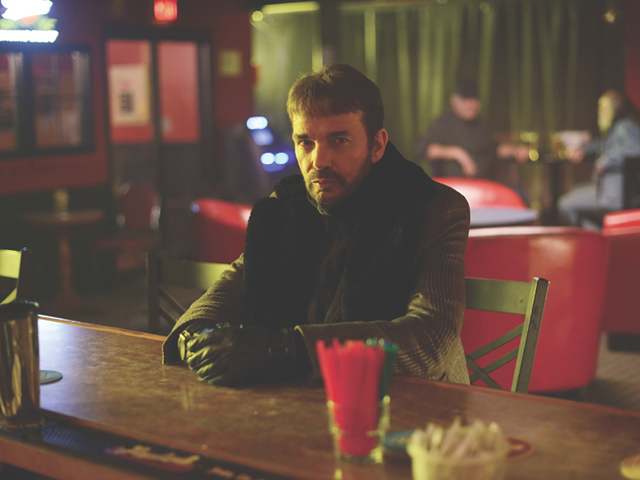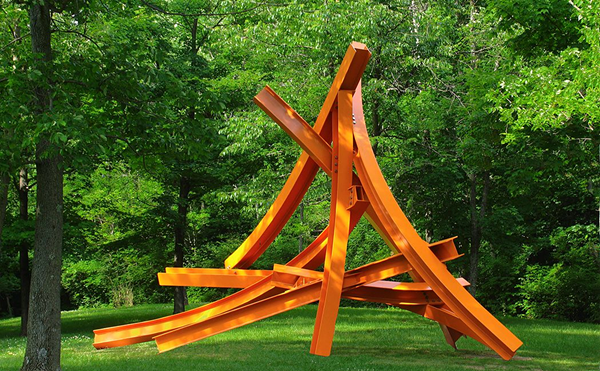You could go stag to see the carved deer heads, football helmets and other gaming trophies on exhibit in Wild Card at the 21c Museum Hotel downtown. But Michael Combs’ unsettling examination of gender identity and cultural mythology raises so many questions that it’s better not to go hunting alone for answers.
The New York sculptor’s 15-year retrospective takes on humans’ competitive nature and need to find validation through sex, discrimination, power and prizes. Typically, it’s groupthink that determines our personal rites. So, if the ultimate intent of Combs’ art is to change behaviors throughout society, it would follow that individual reactions to the exhibit should be shared within a group. This isn’t a show that can be shrugged off without discussion.
“There’s a lot there to respond to and engage with,” says Alice Gray Stites, 21c’s chief curator. The word “unexpected” comes up a few times in our conversation.
Combs, a Long Island native, is both a craftsman and a conceptualist. Generations of his family guided hunters and fishermen, built boats and made decoys. You’re not surprised at his accuracy with anatomy, or that his skilled hands can transform wood to look like porcelain, marble or leather. But you probably didn’t expect to see ball gags and anal beads in the mouths of his carved animals, or sadomasochistic masks pulled over their heads.
Wild Card is not a condemnation of shooting game, playing sports or other displays of masculinity. Each subject would make a fat, easy target by itself. Combs succeeds as an artist not by going for the kill but by exposing, with humor and cultural or historical references, how we are weak and vulnerable. Leave the exhibit not feeling maimed, but emboldened in new ways. How do the notions of gaming and competition inform how we care about the opposite sex, or about the environment?
“Vulnerability is a source of real strength,” Stites points out. A statement from Combs concludes that, “Sometimes it’s best to be all that you can’t be.”
Combs turns his heritage upside-down with “Spent Cases.” An 1880s skiff, a family heirloom, hangs bottom-side-up from the ceiling. The elongated neck of a swan drapes from the boat to the floor, its head resting amid shotgun shells. The boat is a lasting beauty yet a vessel for ugliness, too. Though we’re not hunted, we are haunted.
Stites says the artist is close to his family, but after a failed attempt in his teens to kill a duck, Combs knew that it would be hard for him to carry on the clan’s traditions. “Apparel” is a carved, oversized military-style coat inspired by a hunting jacket Combs received from his grandfather. “He knew that he couldn’t fill that jacket,” Stites says. So, through art and humor, he both respects and skewers the family business. A patch on the jacket carries the family motto, “I came, I saw, I hunted.” He’s turned the iconic POW-MIA emblem into a symbol with a deer and the initials TOTGA — The One That Got Away.
One of Combs’ strongest works is “Man Up,” a black body suit made of Lincoln Logs and straps from Grundéns outdoor wear that resembles a pregnant torso. Wall text informs visitors that in the Makonde tribe of Tanzania, male teenagers spend weeks carving belly masks like these. The young men then wear them in a dance for the tribe’s elders to demonstrate their readiness to be husbands and fathers. Combs’ feminine piece hangs near a “How the West Was Won” installation that features manly yet minimally protective Dallas Cowboys and Washington Redskins football helmets made of birch and deer antlers.
“Manhood comes from total empathy, not from competition,” Stites says. “The best expression of how to be a man is to be a woman.” The myths of America’s Team and Manifest Destiny have been exposed.
Combs’ art starts conversations, but there remains the feeling that sweeping cultural change is elusive when it comes to gender identity and competition. “The Wish” is a cage holding the pure white stag of lore (see Christianity, Harry Potter, The Lion, The Witch and the Wardrobe and Arthurian legend), as the scene appeared to Combs in a dream.
“The desire to be one with nature seems an insatiable pursuit,” according to a statement from the artist. Instead of promised spiritual transcendence, “The Wish” provokes sadness. If captured, the white stag would become just another vanity trophy. And man’s lonely hunt for meaning still would go on.
MICHAEL COMBS: WILD CARD continues through mid-June at 21c Museum Hotel, 609 Walnut St., Downtown. More: 21cmuseumhotels.com/cincinnati.





